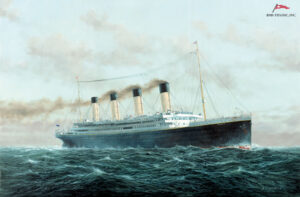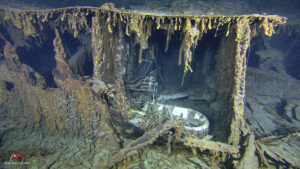Learning About the Titanic: Where Did the Titanic Sink?
The RMS Titanic holds a legendary place in maritime history, known for its grandeur and the tragic events of its maiden voyage in 1912. The story of its sinking continues to captivate and intrigue people around the world. RMS Titanic Inc. is at the forefront of preserving this iconic ship’s legacy. Through their dedicated efforts in exploring and studying the wreck, they ensure that the tale of the Titanic remains vivid and informative for future generations.
The Titanic’s Maiden Voyage and Tragic End

The Titanic set sail on April 10, 1912, from Southampton, England, bound for New York City. It was the largest and most luxurious ship of its time. The Titanic carried over 2,200 passengers and crew. On the night of April 14, 1912, the ship struck an iceberg at around 11:40 PM. The collision caused severe damage to the ship’s hull. Water began flooding into the Titanic, and it soon became clear that the ship was sinking. In the early hours of April 15, the Titanic broke apart and sank, taking more than 1,500 lives with it.
Coordinates and Location of the Sinking
The Titanic sank at the coordinates 41°43’35” N, 49°56’54” W. This location is approximately 370 nautical miles south-southeast of Newfoundland, Canada. The area is known for its icebergs, especially in April when the disaster occurred. The exact location was determined through various expeditions. Robert Ballard’s 1985 expedition finally confirmed the wreck’s location.
The Iceberg Collision
Lookouts Frederick Fleet and Reginald Lee spotted the iceberg late on April 14, 1912. Fleet immediately rang the warning bell and notified the bridge. Despite First Officer William Murdoch’s efforts to turn the ship, it struck the iceberg along its starboard side at 11:40 PM.
The impact caused a series of holes below the waterline, ripping open five of the ship’s sixteen watertight compartments. These compartments were meant to keep the ship afloat even if up to four were breached, but five being compromised was catastrophic. Water began flooding the Titanic, causing it to tilt forward. The design of the Titanic, once deemed unsinkable, could not handle such extensive damage, leading to its eventual sinking.
The Sinking Timeline
The Titanic’s sinking unfolded over approximately two and a half hours. After the collision at 11:40 PM, the crew and passengers quickly realized the severity of the situation. Captain Edward Smith ordered the lifeboats to be prepared and distress signals to be sent. Despite the chaos, the crew worked to maintain order. Lifeboats were launched, but many were only partially filled due to the lack of proper evacuation drills and the initial disbelief that the ship was sinking. Women and children were given priority, leaving many men on board.
At around 2:10 AM, the bow of the Titanic was deeply submerged, and the stern lifted out of the water. The ship’s lights flickered and went out. Moments later, the Titanic broke apart between the third and fourth funnels. The bow and stern sections fell separately to the ocean floor. The bow descended relatively smoothly, while the stern rotated and twisted before sinking. At 2:20 AM, the Titanic vanished beneath the waves. The debris field between the bow and stern is scattered with artifacts and personal items, marking the final resting place of this once-majestic ship.
Depth and Conditions of the Wreck Site
 The Titanic rests at a depth of about 12,500 feet (3,800 meters). The conditions at this depth are extreme. The pressure exceeds 5,000 pounds per square inch, and the temperature is near freezing at 1-2°C (34-36°F). There is no light at this depth, making it completely dark. These harsh conditions have preserved many parts of the ship, but they also present significant challenges for exploration. The bow section is relatively intact, while the stern is heavily damaged and collapsed.
The Titanic rests at a depth of about 12,500 feet (3,800 meters). The conditions at this depth are extreme. The pressure exceeds 5,000 pounds per square inch, and the temperature is near freezing at 1-2°C (34-36°F). There is no light at this depth, making it completely dark. These harsh conditions have preserved many parts of the ship, but they also present significant challenges for exploration. The bow section is relatively intact, while the stern is heavily damaged and collapsed.
The Aftermath and Search for the Wreck
After the sinking, the RMS Carpathia rescued the survivors and brought them to New York. The exact location of the Titanic remained unknown for many years. Early attempts to locate the wreck using sonar and other methods failed. In 1985, a breakthrough came when Robert Ballard and his team discovered the wreck. This discovery provided invaluable insights into the sinking and renewed interest in the Titanic’s story.
RMS Titanic Inc. and the 2024 Expedition

RMS Titanic Inc. is dedicated to the exploration and preservation of the Titanic wreck. They hold exclusive rights as the salvor-in-possession of the wreck. Over the years, they have conducted numerous expeditions, recovering significant artifacts and conducting detailed studies.
Their upcoming 2024 Titanic expedition aims to capture high-quality images of the wreck, explore new sections, and engage the global community. They plan to use advanced technologies to document the wreck and its condition. This expedition will help preserve the Titanic’s legacy and provide new insights into its current state.
Stay Up to Date on the Expedition by Following RMS Titanic Inc.
The sinking of the Titanic is a significant event in maritime history. Understanding where and how the Titanic sank provides insight into the tragedy and its impact. RMS Titanic Inc. plays a vital role in preserving this history through their explorations and educational efforts.
The 2024 expedition promises to bring new discoveries and continue the important work of documenting and preserving the Titanic’s legacy. Follow RMS Titanic Inc. on social media and visit their website to stay updated on the Titanic Expedition 2024. Your support helps keep the memory of the Titanic and its passengers alive for future generations.
